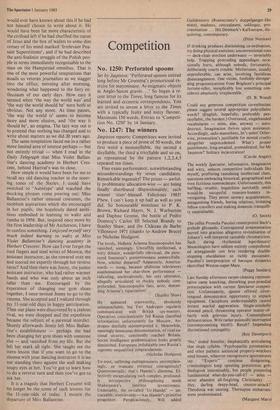Postscript
The brutal truth
Patrick Marnham
Timeplays strange tricks on us all and 1982 should be remembered for the trick it played on Mr Neal Ascherson. Mr Ascherson is a journalist of rare intelligence and distinction, debonair, amusing and for as long as 1 can remember — of solidly left-wing opinions. Before Christmas he wrote an account in the Observer of a journey he had made to Poland in a jugger- naut lorry crammed with essential supplies. Also on board were two special packages. One was a statue of Jesus, the other was 'a box of 1,000 Communion wafers made with non-gluten flour for coeliac children'.
One thinks of Mr Ascherson's intellec- tual battle honours and one shudders at the irony of fate. He was, after all, the founder of the Free Communications Group, the in- terpreter of Marcuse, the man who led the students across Grosvenor Square in 1968 when we charged the police horses; he is the Mr Ascherson who nearly prevented Rudi Dutschke from being deported. For such a man the Sixties must have been a turbulent nightmare, when the forces of darkness seemed to conspire against all his fondest hopes. Every time he led a platoon of the forces of light out into no man's land some shattering reverse was suffered elsewhere on the ideological front. But surely even at his lowest moments, he could not have seen himself as the Santa Claus of the 1980s, providing the essential link between some sickly Polish children and their weekly at- tendance at the Communion rails, a proud volunteer in the sinister army of the Vatican State.
To be fair to Mr Ascherson, nobody would ever have known about this if he had not himself chosen to write about it. He would have been far more characteristic of the civilised left if he had shuffled the statue of Jesus and the box of wafers to some dim corner of his mind marked 'Irrelevant Pea- sant Superstitions', and if he had described the anti-Stalinist struggle of the Polish peo- ple in terms immediately recognisable to the man on the Hampstead omnibus. That is one of the most powerful temptations that assails us veteran journalists as we stagger into the office, morning after morning, wondering what happened to the fiery en- thusiasm of our early days. How easy it seemed when 'the way the world was' and `the way the world should be' were both so obvious. Not any more. As time, passes, `the way the world is' seems to become more and more elusive, and 'the way it should be', an enigma. The lazy way out is to pretend that nothing has changed and to write about matters as we did 20 years ago.
The same temptation faced me in a rather more limited area of interest perhaps — but not entirely trivial — when I read in the Daily Telegraph that Miss Violet Ballan- tine's dancing academy in Herbert Cres- cent, behind Harrod's was to close.
How simple it would have been for me to recall my old dancing teacher in the sneer- ing tones of the Sixties. I could have switched to 'Autotype' and watched the mocking phrases come pouring out: Miss Ballantine's rather unusual costumes, the snobbish aspirations which she encouraged in her pupils, the hopelessly dated ambi- tions embodied in learning to waltz and rumba in 1956. But, inspired once more by the firm leadership of Mr Ascherson, I have to confess something. I enjoyed myself very much indeed learning to waltz at Miss Violet Ballantine's dancing academy in Herbert Crescent. How can I ever forget the cool fingers and steel wrists of Monica, the assistant instructor, as she towered over me and steered me expertly through her reverse turns? And then there was Jenny, the junior assistant instructor, who had rather warmer hands and who was only about an inch taller than me. Encouraged by the experience of changing our gym shoes together, I once invited Jenny to go to the cinema. She accepted and I waltzed through my 11-year-old days in happy anticipation. Then our plans were discovered by a jealous rival, we were shopped and the expedition became the subject of a parental interdict. Shortly afterwards Jenny left Miss Ballan- tine's establishment — perhaps she had been changing her gym shoes with someone .else — and vanished from my life. But she left her mark all right. She taught me the stern lesson that if you want to go to the cinema with your dancing instructor it is no use standing there against the wall making soupy eyes at her. You've got to learn how to do a reverse turn and then you've got to ask her.
It is a tragedy that Herbert Crescent will no longer be the scene of such lessons for the 11-year-olds of today. I mourn the departure of Miss Ballantine.



































 Previous page
Previous page